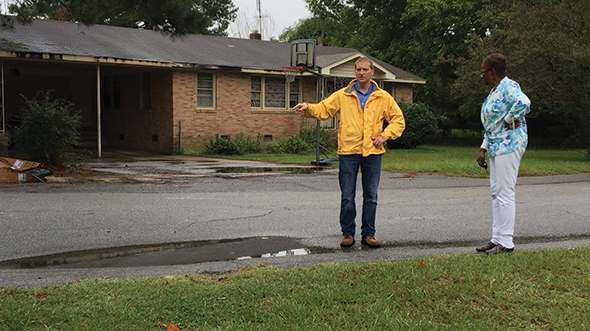
BLOG
—
Asset Management is Not About Assets… It’s About People
In the asset management world, we talk about asset management being a “journey,” as if the assets go somewhere. But assets aren’t the travelers here; it is the people within an organization who embark on that journey. A successful asset management program begins with people and ends with people; not with assets.
When communities adopt an asset management program, their early attention is often on the assets. That seems logical. They start with questions like, “Where are our assets, and what condition are they in?” They also focus on asset data and tools to manage assets, asking, “What data do we need to collect and in what format? What computerized maintenance management system will we use to track work? How will we develop repair and replacement plans?”
My early efforts at developing asset management programs focused on assets as well, and the communities I worked with struggled to get their programs moving. But these experiences helped define what is needed to ensure a highly rewarding asset management journey.
Choosing Travel Partners
To create a successful asset management program, you must first focus on the people involved. Asset management is not a solo trip—it is a family event, and everyone must follow the same itinerary. Once you have the right people in the car, then, and only then, should the focus shift to the assets.
The first questions a community should ask when embarking on an asset management journey are:
- “Who should we include on the journey?”
- “Who will the program impact the most?”
- “Who is needed to make the journey successful?”
- “Who will drive the program?”
- “Who is most likely to put up a roadblock?”
This conversation often leads to surprising results, but it is essential to a program’s success.
As with any journey, you need a driver. For an asset management program to succeed, you need an asset manager. This person does not have to bear that title, but he or she must have bought in to the purpose of the trip, know where the family is headed and know how to get there. It helps if they have a license to drive or, in the case of asset management, certification or training as an asset manager—but that is not mandatory. Because asset management terminology can be a foreign language to those not engaged in the daily management of assets, this person also serves as the program’s interpreter.
Work Together Throughout the Trip
Asset management typically directs both operation and maintenance (O&M) activities and capital improvement project (CIP) implementation. For most communities, responsibilities for O&M and CIP lie with two separate groups: operations (i.e., public works) and engineering, respectively. It is essential that both groups participate fully in planning and navigating the journey. If the driver comes from one group, then the navigator should come from the other group. This redundancy also protects the journey in case the driver leaves the community.
Never take a car on a journey without permission from the owner, and never start a new asset management program without the approval of community leadership. Keep in mind that sometimes it is necessary to have multiple interactions with leadership about the significance of the destination and the benefits of each milestone. Predictive and proactive management of assets can be a new concept and new way of doing business, and cultural change is often slow. Be patient. It is better to delay the start of a trip to ensure everyone is on board than to jump out early and get called back to the house.
Very few journeys are free and the longer the journey, the more it costs. Asset management, when done properly, adds tremendous value to the community system, increases organizational efficiency and provides a higher level of service to the customer. But, depending on the maturity of the community’s asset management program, development can require a sizeable investment. Finance directors understand the language of money and generally have the ear of those who control community funding. When the finance director understands the financial benefits and overall costs of the program, he or she can become a strong advocate for the trip and help navigate the nuances of program funding—e.g., people, tools and data—over the long haul. Bringing the finance director along for the ride helps ensure the entire trip will be sufficiently funded.
As noted earlier, this is a family trip. And that family includes engineering leadership and staff, operations managers, frontline supervisors, maintenance staff, etc. Don’t wait until the car is out of the driveway before alerting the rest of the family that they are required to travel with you. Explain the trip early and often—where you are going and why, the benefit to each participant, the opportunities along the way and that you will pack everything needed to enjoy the ride. Expect pushback from some, not everyone enjoys taking trips to unseen destinations. Be patient and keep reassuring them that you will be with them every mile of the way—and then prove it. In other words, identify and celebrate early successes; especially those that impact other groups.
Prepare for Roadblocks
Almost every journey comes with challenges. Just like you check your car’s oil and pack an umbrella before a family road trip, it is wise to be prepared for issues you may encounter along your asset management journey.
Homesickness. Invariably someone, somewhere along the way will want to go home. They will want to return to the old way of doing things because the old way is familiar and comfortable. They don’t grasp the new processes or tools, and change is difficult. This is the point where Mom and Dad (aka community leadership) must be on the same page. The driver needs to focus on the road ahead, and leadership must step in to remind everyone that there is no turning around.
Flat tire. If you have the car packed and everyone buckled in but have failed to check the condition of your car, you may not get very far. Make sure your goals are clearly stated and understood, an overall strategy is in place and aligned with your goals, and that the plans, tools and business processes are adequately in place and tested prior to beginning the journey. If not, the program may limp along as if it has a tire flat.
Even with the best planning, there can be unforeseen roadblocks along the way. Build flexibility into your route. If a major event (like our current pandemic) occurs and funding falls short, slow down and reassess. Consider additional training or examining business processes, rather than conducting intensive field data collection. There are many stops along the way; don’t be so focused on the destination that you overlook incremental goals.
Running out of gas. Ensuring there is enough gas to get to your next stop is usually a job that falls on the driver. The asset management journey can be a long one, so make sure you have the energy and time needed to complete the trip. To the highest extent possible, secure a stable funding source to finance your short-range and midrange activities, identify stops along the way where you can refuel and refocus and, at least annually, perform a review of your goals, strategy and program successes.
Let Us Help Guide Your Journey
Engage the right people and create a sound strategy to avoid potholes and you will have a safe and satisfying asset management journey. If you would like a tour guide along the way, feel free to contact me at hal.clarkson@woolpert.com.



